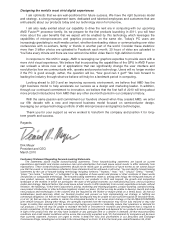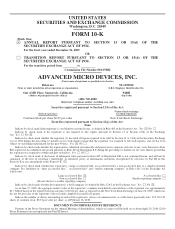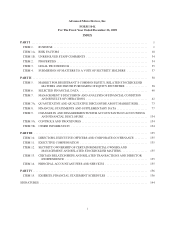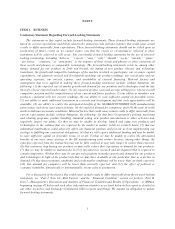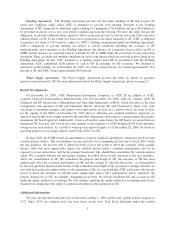AMD 2009 Annual Report Download - page 14
Download and view the complete annual report
Please find page 14 of the 2009 AMD annual report below. You can navigate through the pages in the report by either clicking on the pages listed below, or by using the keyword search tool below to find specific information within the annual report.Our microprocessors and chipsets are incorporated into computing platforms that also include graphics
processing units, or GPUs, and core software. A platform is a collection of technologies that are designed to work
together to provide a more complete computing solution. We believe that integrated, balanced platforms
consisting of CPUs, GPUs, and chipsets that work together at the system level bring end users improved system
stability, increased performance and enhanced power efficiency. Also, by offering our customers an all-AMD
platform, we are able to provide them with a single point of contact for the key platform components and enable
them to bring the platforms to market faster in a variety of client and server system form factors.
Server and Workstation. Our microprocessors for servers and workstation platforms consist primarily of
our six-core, quad-core and dual-core AMD Opteron™processors. A server is a system that performs services for
connected clients as part of a client-server architecture. Servers are designed to run an application or applications,
often for extended periods of time with minimal human direction. Examples of servers include web servers,
e-mail servers, database services, file servers and print servers. A workstation is a high-end PC, designed for
technical applications such as computer-aided design and digital content creation. Workstations usually offer
higher performance than is normally seen on a PC, especially with respect to graphics, processing power,
memory capacity and multitasking activity.
We design AMD Opteron processors for servers and workstations with Direct Connect Architecture to
enable simultaneous 32-bit and 64-bit computing. These processors can be used in a variety of server
applications, including database processing (enterprise resource planning, customer relationship management and
supply chain management) and business intelligence. They can also be used in applications such as engineering
and digital content creation and other information technology infrastructure applications such as intensive Web
serving, cloud computing, high performance computing and email messaging. Cloud computing is a computing
model where data, applications and services are delivered over the Internet. High performance computing
involves the use of AMD Opteron processor based supercomputers and computer clusters to solve advanced
computational problems in industries ranging from oil and gas to weather forecasting. AMD Opteron processors
also allow enterprise customers to efficiently implement virtualization across their businesses. Virtualization is
the use of software to allow multiple discrete operating systems and application environments to share a single
physical computer by providing the illusion that each operating system has full control over the underlying
hardware. By enabling different operating systems and applications to run on the same server, virtualization
offers the benefit of consolidating workloads and reducing hardware requirements, which can also reduce power,
cooling and system management costs.
In June 2009, we introduced our six-core server processor with Direct Connect Architecture for two-, four-
and eight-socket servers. These processors incorporated six processor cores on a single die of silicon and added a
6MB shared L3 cache. The increased cache helps increase the speed of memory-intensive applications. Our new
six-core AMD Opteron processors are more energy efficient than our previous generation quad-core processors.
Furthermore, the six-core AMD Opteron processors leverage existing platform infrastructure and a low-cost,
power-efficient DDR-2 memory architecture, a memory technology used for high speed storage of working data,
which can help lower system acquisition costs for end users. High performance computing (HPC), virtualization
and database workloads can also benefit from the increased memory bandwidth enabled by HyperTransport™
technology and HT Assist, which helps reduce processor to processor latency and traffic. Finally, AMD
Virtualization™ (AMD-V™) technology and the AMD-P suite of power management features are available
across all performance and power bands, so that our customers do not have to compromise on saving power in
order to obtain the highest performing product.
Client Notebook. There has been a shift in consumer demand towards thinner and lighter notebook
platforms with longer battery life. To participate in this market shift, we are increasing our investment in low
power notebook platforms. In January 2009, we launched the “Yukon” platform, which was our code name for
our first generation ultrathin notebook platform. The Yukon platform incorporates the AMD Athlon Neo
processor with ATI Radeon™ X1250 integrated graphics and ATI Mobility Radeon™ HD 3410 discrete
graphics. The Yukon platform offers a complete PC experience at lower price points. Our second generation
6


